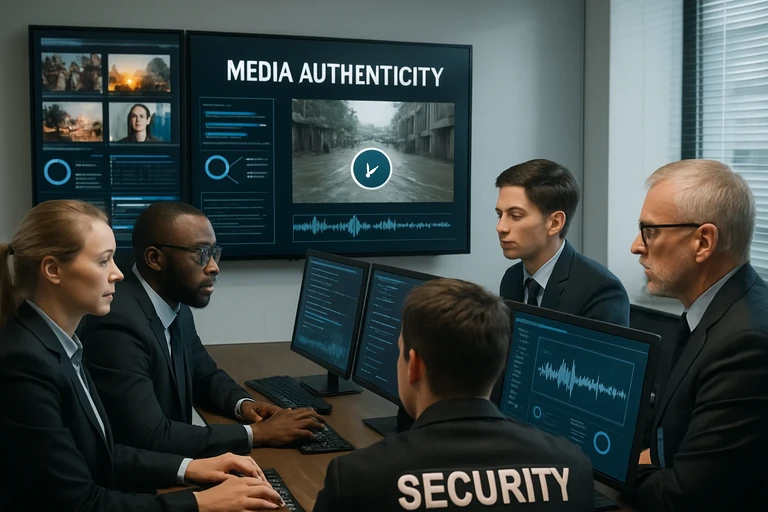The Rise of Autonomous Agents in 2025 explores practical patterns, platforms, and governance conside...

Deepfakes and AI: How to Protect Your Company
Deepfakes and AI-driven deception pose real risks to businesses, from executive impersonation to brand harm. This comprehensive guide offers a practical, step-by-step approach to building defense-in-depth, leveraging content provenance, detection, and incident response to protect your company.
Introduction
As AI-enabled media grows more convincing, businesses face a new class of threats: deepfakes and synthetic content that impersonate leaders, alter communications, and undermine trust. From executive impersonation during wire transfers to AI-generated videos used for brand harm, the risks are real and evolving. Leading organizations are already building defense-in-depth strategies that combine people, processes, and technology to verify authenticity, protect sensitive actions, and respond quickly when something goes wrong. This article offers practical, field-tested guidance you can apply today, regardless of your industry or company size. Key takeaway: treat deepfakes as a risk to identity, integrity, and trust—then design controls that verify who spoke, what they asked, and why.
Recent reporting and industry analysis highlight how fast the threat is moving. News coverage and security analyses emphasize executive impersonation, voice cloning, and the rapid maturation of AI-generated media as corporate risks—and they point to concrete steps like multi-factor authentication, out-of-band verification, and incident planning as essential defenses. For example, analysts and journalists have documented real-world deepfake incidents and the resulting demand for stronger verification and governance around AI-enabled content and communications.
The Deepfake Threat Landscape for Modern Businesses
Deepfakes come in several forms—video, audio, and text—each offering a pathway for social engineering, fraud, or reputational harm. Common use cases include:
- Executive impersonation: A convincing video or audio clip persuades staff to transfer funds or reveal credentials.
- Vendor and partner impersonation: Fraudsters pose as trusted suppliers or executives to change payment details or approve rogue transactions.
- Disinformation and brand risk: Synthetic media spreads false statements about a company, triggering stock or market reactions or damaging trust with customers.
The stakes are rising. In recent years, high-impact cases and insurer-facing warnings have underscored the financial and operational risk of deepfakes, including executive fraud schemes and the need for robust controls. Industry reporting notes that the risk is not theoretical—it's happening in real business contexts and is increasingly covered by cyber and crime insurance expectations.
Why this matters now
Modern organizations operate on real-time, multi-channel communication—email, chat, video meetings, and voice calls. Deepfakes exploit the gaps between channels and expectations: urgency, authority, and the assumption that voice or face matches the trusted source. This is why a zero-trust mindset (verify everything) and multi-factor verification for high-risk actions are foundational defenses. Investments in content provenance, detection capabilities, and incident response planning are increasingly expected by insurers and regulators alike.
Defense-in-Depth: A Practical Security Architecture
Protecting your company against deepfakes requires layered controls that harden every step from request to action. A pragmatic architecture combines identity verification, content provenance, detection tools, and incident response planning.
1) Build a Zero-Trust Foundation
Zero trust is the guiding principle: never assume a request is legitimate simply because it comes from an internal channel or a familiar contact. Continuously verify identity, device, context, and the action’s risk level before permitting sensitive operations. This framework helps prevent deepfake-driven fraud by requiring ongoing authentication and contextual checks, not just one-off credentials. Key takeaway: design workflows that require cross-checks for high-stakes actions like payments or changes to vendor details.
2) Strengthen Authentication and Verification
Multi-factor authentication (MFA) should be standard—ideally phishing-resistant MFA such as FIDO2/WebAuthn keys or equivalent strong methods. For high-risk actions (e.g., executive money transfers), employ out-of-band verification: confirm requests via a separate channel or in-person/phone validation using known contact information. Redundancy here is not optional; it’s a practical defense against AI-assisted social engineering.
3) Establish a Deepfake Incident Response Plan
An effective plan designates who investigates, who communicates externally, and how to contain and recover from an incident. Include playbooks for rapid escalation, internal and external communications, and a post-incident review. Regular tabletop exercises—simulating deepfake scenarios—can reveal gaps in processes and governance.
4) Monitor and Detect: Technical Defenses that Help Even When Humans Are Busy
Detection tools, while not perfect yet, are improving. Companies use AI-analyzed signals to flag potential manipulations in video, audio, and images. In parallel, organizations should train staff to spot obvious red flags and maintain rapid reporting channels. A layered approach—detection tools plus human review—helps shorten the time from suspicious content to verified action.
5) Content Authenticity and Provenance to Protect Media Assets
Provenance metadata and content credentials provide a durable way to attach attribution and authenticity information to digital media. Industry initiatives and vendor tools are expanding across platforms to help verify who created content, how it was produced, and whether AI was involved. This is especially useful for marketing, PR, and product media where authenticity matters as much as security. Adopt content provenance where possible, and educate teams on how to view and validate credentials.
Content Authenticity at Scale: What Companies Can Do Today
The Content Authenticity Initiative (CAI) and its open-standard approach are increasingly embedded in workflows and platforms. CAI aims to provide a provenance framework that persists across platforms, helping organizations and consumers assess content authenticity even after sharing or reposting. For businesses, this translates into practical steps like embedding content credentials in media assets and enabling easy inspection in browsers and apps.
- Embed Content Credentials in media assets to indicate creators, editing history, and AI usage preferences.
- Use inspection tools and browser extensions to verify credentials on web content.
- Encourage suppliers and partners to publish content credentials for media they share about your brand.
Adobe’s CAI and Content Credentials, along with industry support, provide a path toward greater transparency and trust in media—an important layer of defense against misinformation and impersonation. Adoption is voluntary today, but momentum is growing across media, e-commerce, and marketing ecosystems.
How to start with CAI in practice
- Audit your media library to identify where content credentials could be applied (images, videos, audio, and posts that include brand claims).
- Pilot Content Credentials on a subset of media assets using compatible tools (e.g., Adobe apps that support credentials and the CAI extension).
- Establish governance to respect creators’ preferences for AI training and content usage, and communicate these options to your teams and partners.
Detection and Verification: What Technology Can and Cannot Do
Detection technologies add a valuable layer, but they are not a silver bullet. Best practice combines automated detection with human review and strong governance. The National Institute of Standards and Technology (NIST) has actively studied media manipulation and published guidance on morph-detection and related evaluation methods to help organizations deploy robust detection capabilities. This work emphasizes practical deployment considerations and the importance of combining tools with processes.
For example, recent NIST guidance outlines considerations for implementing morph-detection technology to scrutinize images that could be used in identity verification scenarios, helping reduce the risk of identity fraud through altered media. This is especially relevant for customer-facing or regulatory workflows that rely on facial recognition or identity checks. Organizations should evaluate morph-detection capabilities as part of a broader strategy that includes provenance, verification workflows, and human review.
Other reputable sources emphasize a layered approach: zero-trust verification, MFA, red-teaming exercises, and formal incident response planning. As deepfakes become more credible, companies are increasingly adopting a holistic approach that blends technology with disciplined governance.
People, Process, and Policy: The Human Factor
Technology alone cannot eliminate risk. A culture of cyber awareness, ongoing training, and tested procedures is essential. Practical steps include:
- Regular deepfake awareness training for all employees, with emphasis on recognizing voice and video manipulation indicators and abnormal requests.
- Phishing-resistant MFA for all critical accounts, and additional verification for high-risk financial actions.
- Simulated deepfake phishing exercises (red-team testing) to improve staff readiness and refine response protocols.
- A formal incident response plan that includes crisis communications, external reporting, and brand reputation management.
Industry guidance highlights the value of training and least-privilege access as foundational controls. In practice, these measures help reduce the likelihood that a successful deepfake succeeds in compromising systems or funds, while ensuring a swift, coordinated response if one occurs.
A Practical 6-Week Plan to Build Deepfake Resilience
- Week 1–2: Risk Assessment and Governance – Map high-risk processes (payments, vendor changes, password resets) and identify where deepfakes could cause harm. Establish a policy that executive requests require out-of-band verification for critical actions.
- Week 2–3: strengthen authentication – Roll out phishing-resistant MFA (FIDO2 or equivalent) for key accounts; issue security keys to executives and finance staff. Implement strong access controls and device posture checks.
- Week 3–4: implement content provenance – Begin pilot with Content Credentials on key media assets and enable credential inspection in select workflows. Educate teams on how to view and verify credentials.
- Week 4–5: detection and processes – Deploy a basic deepfake detection toolkit and establish a triage process for suspicious media. Create clear escalation paths and incident response playbooks.
- Week 5–6: testing and training – Run red-team simulations that use synthetic media to test workflows; deliver targeted training to high-risk groups (finance, HR, executive assistants).
- Week 6 and beyond: sustain and adapt – Review outcomes, refine controls, and expand CAI credential adoption to more media assets and partner ecosystems. Monitor evolving threats and update the incident response plan accordingly.
Insurance, Regulation, and Responsibility
As AI-generated threats proliferate, insurers and regulators are increasingly attentive to controls around deepfakes. Insurers may require demonstrated security controls and incident plans as a condition for coverage or favorable terms, reflecting the evolving risk landscape. This underscores the business case for implementing the defense-in-depth approach outlined above and documenting your readiness. For example, Reuters reports that insurers are responding to AI-based risks with more rigorous coverage options and conditions, including governance expectations for deepfake incidents.
Conclusion: Proactive, Practical, and Scalable Protection
Deepfakes and AI-enabled deception are not a distant threat—they are a present risk that requires a structured, scalable response. By building a zero-trust foundation, strengthening authentication, embracing content provenance, investing in detection with human oversight, and training people to respond quickly, your company can reduce the likelihood and impact of deepfake attacks. The steps outlined here—rooted in real-world experience and current industry guidance—are designed to be practical for mid-market teams and scalable as your organization grows.
Remember, the goal is not to eliminate AI risks entirely (an impossible task) but to make it harder for bad actors to succeed and to ensure your organization can detect, verify, and respond decisively when a synthetic threat appears. As the AI and media landscape evolves, stay informed, practice good governance, and collect evidence to continually improve your defenses.


